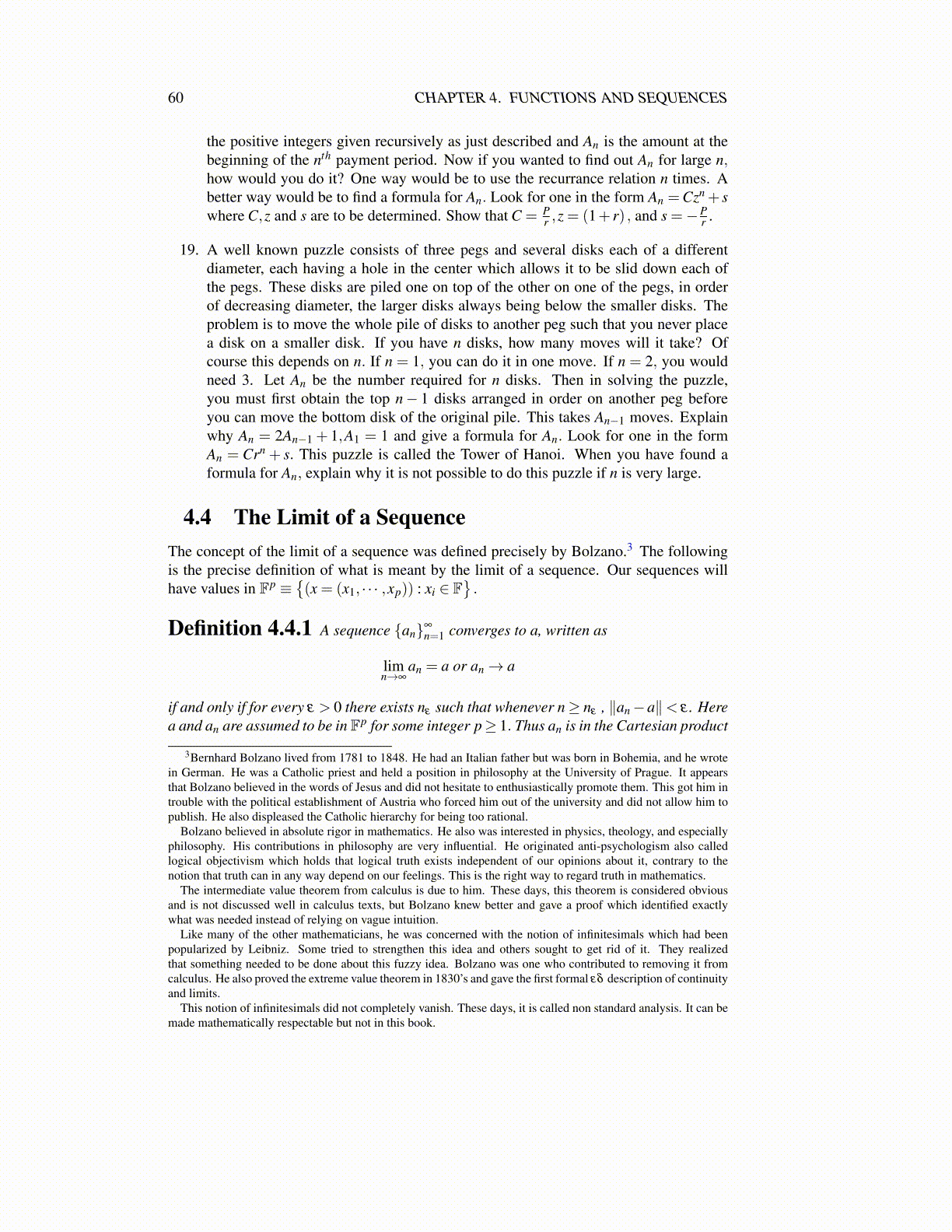60 CHAPTER 4. FUNCTIONS AND SEQUENCES
Example 4.4.6 Let an = n2.
Then in this case limn→∞ an does not exist. This is so because an cannot be eventuallyclose to anything.
Example 4.4.7 Let an = (−1)n .
In this case, limn→∞ (−1)n does not exist. This follows from the definition. Let ε = 1/2.If there exists a limit, l, then eventually, for all n large enough, |an− l| < 1/2. However,|an−an+1|= 2 and so, 2= |an−an+1| ≤ |an− l|+ |l−an+1|< 1/2+1/2= 1 which cannothold. Therefore, there can be no limit for this sequence.
Theorem 4.4.8 Suppose {an} and {bn} are sequences, an ∈ Fp,bn ∈ Fp and that
limn→∞
an = a and limn→∞
bn = b.
Also suppose x and y are in F. Then
limn→∞
xan + ybn = xa+ yb (4.3)
If an ∈ F,bn ∈ Fp,limn→∞
anbn = ab (4.4)
limn→∞
aqn = aq (4.5)
If b ̸= 0 and b ∈ F and an ∈ Fp,
limn→∞
an
bn=
ab. (4.6)
Proof: The first of these claims is left for you to do. To do the second, let ε > 0 begiven and choose n1 such that if n ≥ n1 then |an−a| < 1. Then for such n, the triangleinequality implies
∥anbn−ab∥ ≤ ∥anbn−anb∥+∥anb−ab∥ ≤ |an|∥bn−b∥+∥b∥|an−a|≤ (|a|+1)∥bn−b∥+∥b∥|an−a| .
Now let n2 be large enough that for n≥ n2,
∥bn−b∥< ε
2(|a|+1), and |an−a|< ε
2(∥b∥+1).
Such a number n2 exists because of the definition of limit. Therefore, let nε > max(n1,n2) .For n≥ nε ,
∥anbn−ab∥ ≤ (|a|+1)∥bn−b∥+∥b∥|an−a|
< (|a|+1)ε
2(|a|+1)+∥b∥ ε
2(|b|+1)≤ ε.
This proves 4.4. Then 4.5 follows from this by induction in the above case where bn ∈ F.Next consider 4.6. Let ε > 0 be given and let n1 be so large that if n≥ n1, |bn−b|< |b|
2 .Thus for such n,∥∥∥∥an
bn− a
b
∥∥∥∥= ∥∥∥∥anb−abn
bbn
∥∥∥∥≤ 2
|b|2[∥anb−ab∥+∥ab−abn∥]
60 CHAPTER 4. FUNCTIONS AND SEQUENCESExample 4.4.6 Let a, =n".Then in this case lim,_;..d, does not exist. This is so because a, cannot be eventuallyclose to anything.Example 4.4.7 Let a, = (—1)".In this case, limy—yco (—1)" does not exist. This follows from the definition. Let € = 1/2.If there exists a limit, 7, then eventually, for all n large enough, |a, —/| < 1/2. However,lan — An41| =2 and so, 2 = |an — An41| < |an — 1) +|2— an41| < 1/2+1/2 = 1 which cannothold. Therefore, there can be no limit for this sequence.Theorem 4.4.8 suppose {a,} and {by} are sequences, dy € F? by € F? and thatlim a, = aand lim by, = b.n—-eo n—-ooAlso suppose x and y are in F. Thenlim xa, + yb, = xa+yb (4.3)n-ooIfa, € Fb, € F?,lim a,b, = ab (4.4)n—colim af = a! (4.5)n—- eoIfb #0 and b € F anda, € F?,. a, alim — = -. 4.6n>b, Dd (4.6)Proof: The first of these claims is left for you to do. To do the second, let € > 0 begiven and choose n; such that if n >, then |a,—a| < 1. Then for such n, the triangleinequality implies\|anbn — ab|| \|anPn — Anb|| + ||@nb — abl| < |an| |lbn — bl] + [ll] lan — 4<< (lal+1) |]bn —4)| + ||| lan — a].Now let 2 be large enough that for n > nz,Ibn -bIl <5and | |< .—— dn —a(lal +1)’ , 2(||| +1)Such a number 7 exists because of the definition of limit. Therefore, let ng > max (11,72) .For n> ne,\lanbn —abl| < (jal+1)|!bn —b]| + |]|| an — a< ay + lll sap(\a| +1) 2(|b| +1This proves 4.4. Then 4.5 follows from this by induction in the above case where b, € F.Next consider 4.6. Let € > 0 be given and let n; be so large that if n > m1, |b, —b| < aThus for such n,< (lal +1) 5 y <&2< md [|l@nb — ab|| + lab — abn ||]a.an aynb — abybnbby@b
